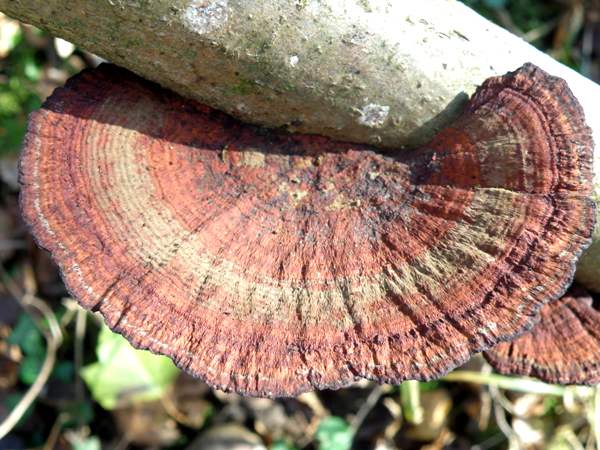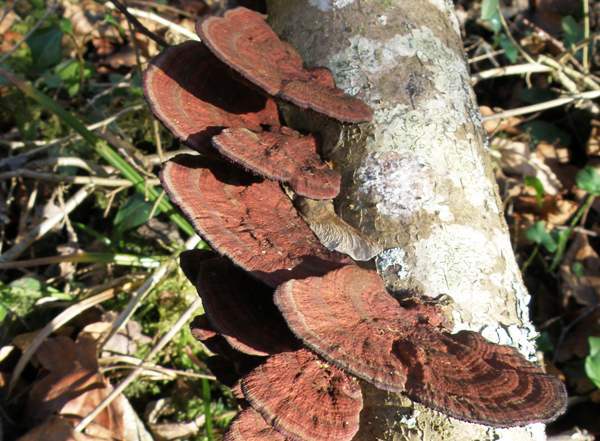Trees Birds Mammals Fish Amphibians Reptiles
Wild Algarve
Bookshop
Daedaleopsis tricolor (Bull.) Bondartsev & Singer
Phylum: Basidiomycota - Class: Agaricomycetes - Order: Polyporales - Family: Fomitopsidaceae
Distribution - Taxonomic History - Etymology - Identification - Culinary Notes - Reference Sources

From the top this attractive bracket is easily misidentified. There are so many colour variations in Trametes versicolor that it is almost forgivable to assume that any fan-shaped thin bracket with concentric, many-zoned bands on its upper surface must be yet another Turkeytail. No so! Although usully reddish and certainly not as variable in colour as Turkeytail Trametes versicolor, is a thin and leathery fan-like bracket, , usually tiered, and with many concentric colour bands.There is one very important feature distinguishing it from Turkeytail... it has gills.
Daedaleopsis and Lenzites species have definite gill-like slots rather than pores. They aren’t merely very long mazegill slots either, but structures very similar to the gills of an agaric mushroom. They are, nevertheless, polypores – taxonomically, that is!

Distribution
An uncommon but conspicuous bracket fungus, the Birch Mazegill is found occasionally throughout Britain and Ireland.
Taxonomic history
Originally described in 1792 by pioneering French mycologist Jean Baptiste Francois Bulliard as Agaricus tricolor, this close relative of Blushing Bracket Daedaleopsis confragosa was long cnsidered merely a colour variation of the latter. The currently-accepted scientific name Daedaleopsis tricolor dates from a 1953 publication by Appollinaris Semenovich Bondartsev (1877 – 1968) and Rolf Singer (1906 - 1994).
Synonyms of Daedaleopsis tricolor include Agaricus sepiarius var. tricolor (Bull.) Pers., Daedalea tricolor (Bull.) Fr., Lenzites tricolor (Bull.) Fr., Trametes tricolor (Bull.) Lloyd, and (as recently as 2001) Ischnoderma tricolor (Bull.) Zmitr.
Etymology
The generic name Daedaleopsis means 'having the appearance of Daedalea' (which is the genus in which you will find the Oak Polypore, Daedalea quercina; and the specific epithet tricolor means 'of three colours' - a reference to the colour bands on the upper surfaces of these brackets.
Identification guide
 |
Fruitbody
Many-zoned, often reddish fan-like brackets, up to 10 cm across and 1 to 2 cm thick at the point of attachment; usually in tiers.
The gills are white at first, turning brown with age; well-spaced or fairly close; sharp-edged; tough; up to 1 cm deep. |
|
Spores
Cylindrical, smooth, 7-11 x 2-3µm; inamyloid.
Spore print
White. |
Odour/taste |
Not distinctive |
Habitat & Ecological role |
On living or dead hardwood trees, particularly willows.. |
Season |
All through the year, but shedding spores in
autumn. |
Similar species |
Trametes versicolor, Turkeytail, has pores rather than gills. |
Culinary Notes
This bracket fungus is tough and inedible.
Reference Sources
Fascinated by Fungi, 2nd Edition, Pat O'Reilly 2016, reprinted by Coch-y-bonddu Books in 2022.
Dictionary of the Fungi; Paul M. Kirk, Paul F. Cannon, David W. Minter and J. A. Stalpers; CABI, 2008
Taxonomic history and synonym information on these pages is drawn from many sources but in particular from the British Mycological Society's GB Checklist of Fungi.
Top of page...
Fascinated by Fungi. Back by popular demand, Pat O'Reilly's best-selling 450-page hardback book is available now. The latest second edition was republished with a sparkling new cover design in September 2022 by Coch-y-Bonddu Books. Full details and copies are available from the publisher's online bookshop...